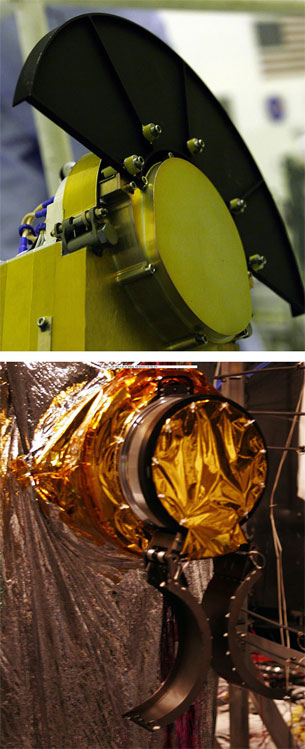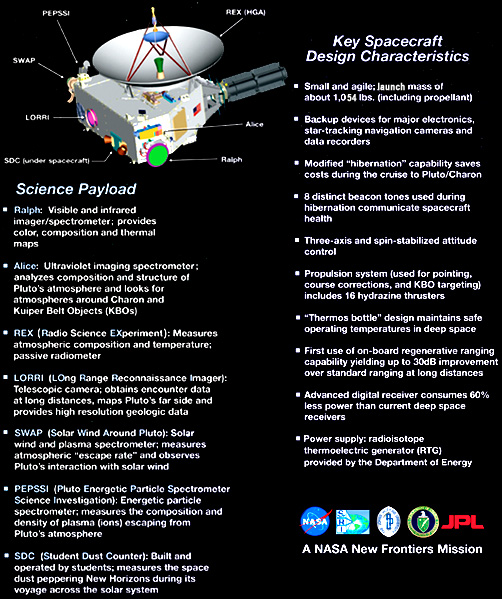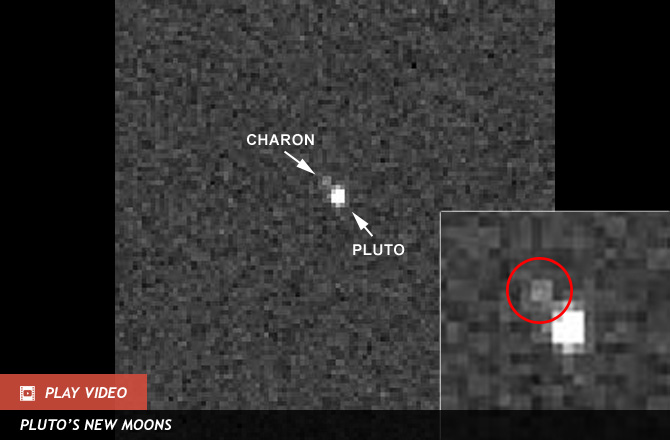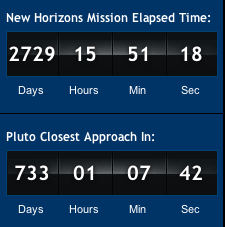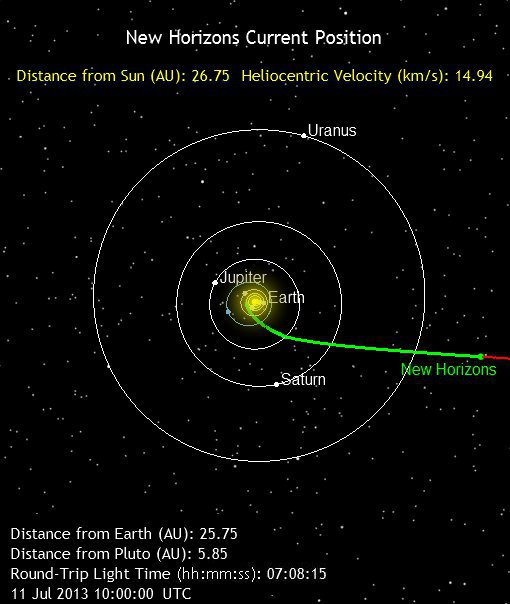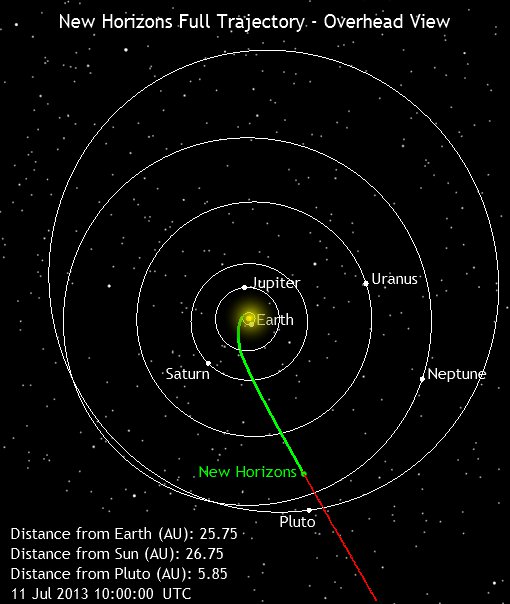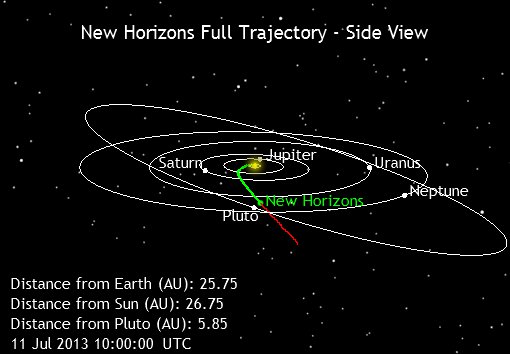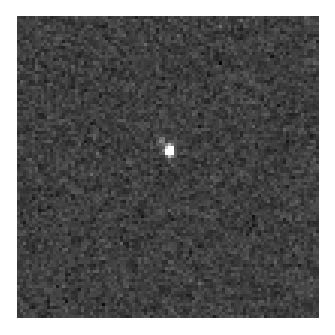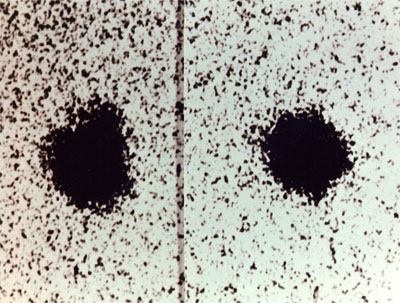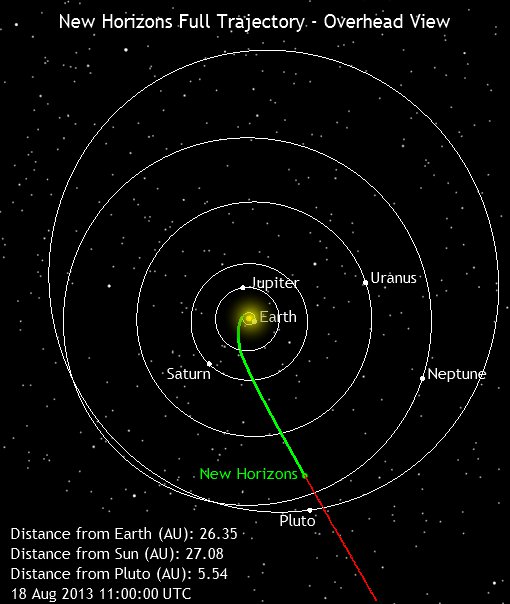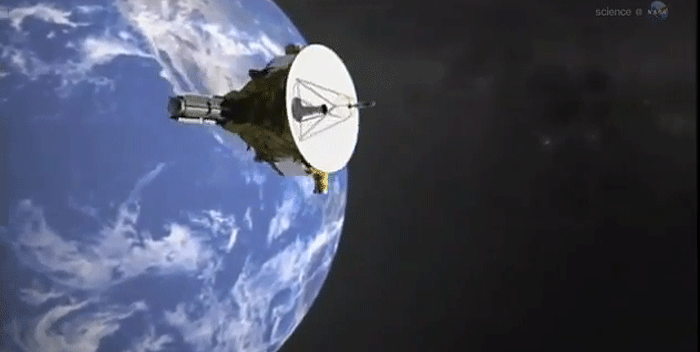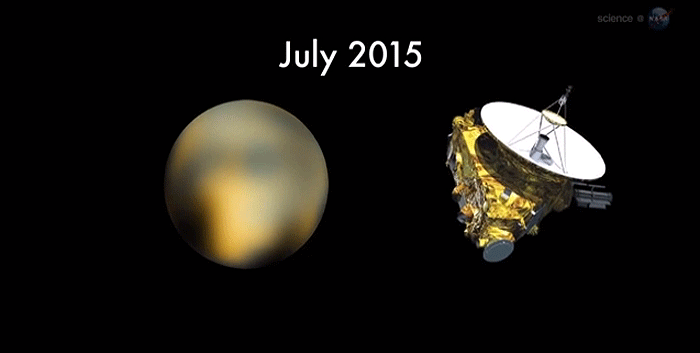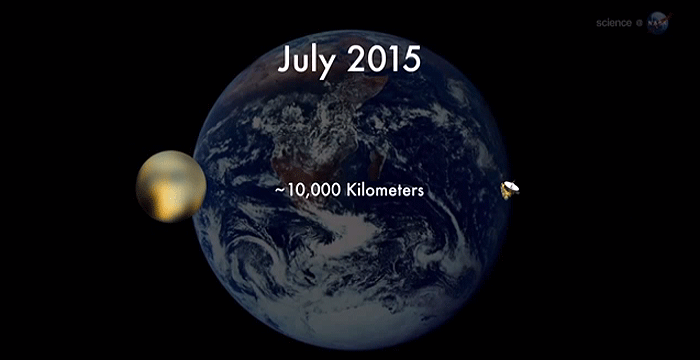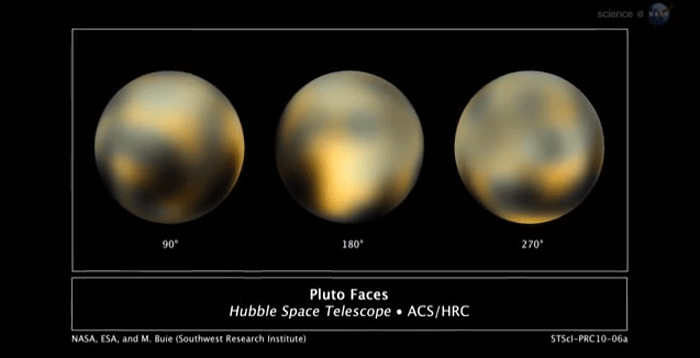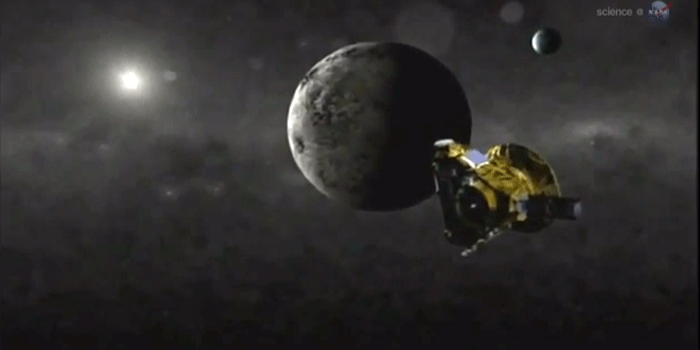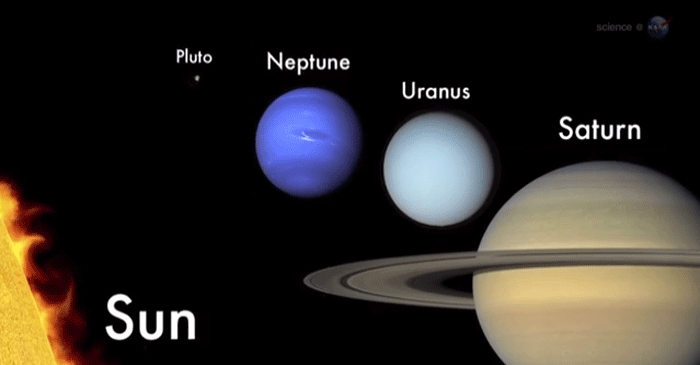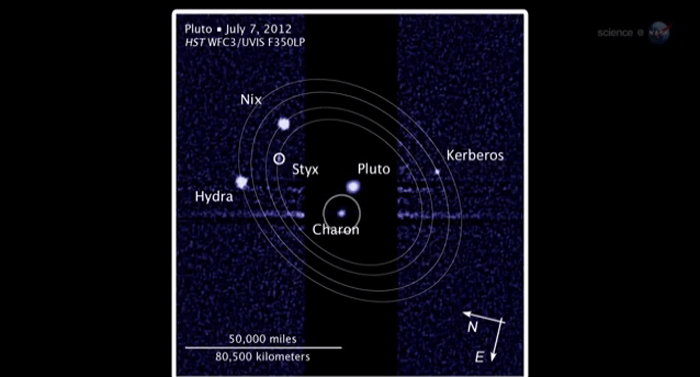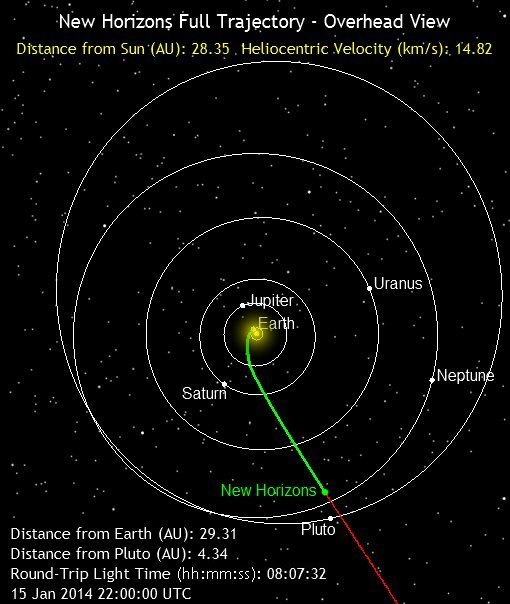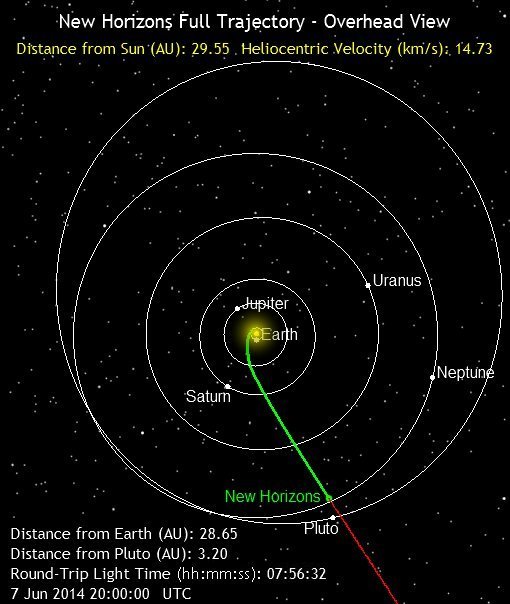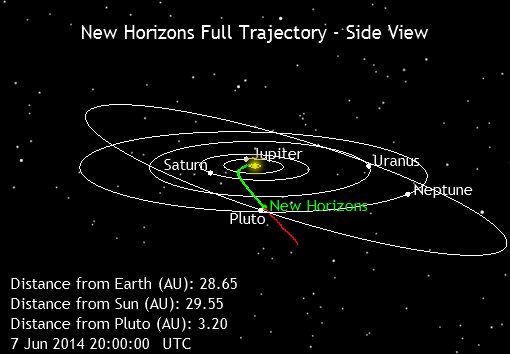Unless significant new hazards are found, expect NASA’s New Horizons spacecraft to stay on its original course past Pluto and its moons, after mission managers concluded that the danger posed by dust and debris in the Pluto system is less than they once feared.
The New Horizons team recently completed an 18-month study of potential impact hazards – mostly dust created by objects hitting Pluto’s small satellites – the spacecraft would face as it speeds some 30,000 miles per hour (more than 48,000 kilometers per hour) past Pluto in July 2015. The team estimated that the probability of a mission-ending dust impact was less than 0.3 percent if the spacecraft followed the current baseline plan, far below some early, more conservative estimates. So, with the concurrence of an independent review panel and NASA, the project team expects to keep New Horizons on this baseline course, which includes a close approach of about 12,500 kilometers (nearly 7,800 miles) from the surface of Pluto.
“We found that loss of the New Horizons mission by dust impacting the spacecraft is very unlikely, and we expect to follow the nominal, or baseline, mission timeline that we've been refining over the past few years,” says New Horizons Project Scientist Hal Weaver, of the Johns Hopkins University Applied Physics Laboratory. “Still, we'll be ready with two alternative timelines, in the event that the impact risk turns out to be greater than we think.”
Those alternate plans (called SHBOTs, short for Safe Haven by Other Trajectories) are being developed should new information – gathered from New Horizons camera observations during the approach to Pluto, for example, or new dust-dynamics analyses – indicate less-than-smooth sailing for New Horizons.
One plan, the Generic Inner SHBOT, is essentially the same as baseline trajectory, but with the spacecraft turned so that its 7-foot dish antenna faces the incoming dust particles; this "Antenna-to-Ram" (or ATR) configuration would protect the spacecraft underneath. The Deep Inner SHBOT also employs ATR protection, but would additionally dip the trajectory to within just 3,000 kilometers (nearly 1,900 miles) of Pluto's surface, where atmospheric drag tends to sweep out lingering dust.
Read more about the New Horizons impact-hazard study and SHBOTs
New Horizons managers recently presented their impact-hazard outlook and if-necessary mitigation plans to an independent NASA review panel and to the NASA Science Mission Directorate Program Management Council &ndash receiving endorsements from both.
New Horizons Principal Investigator Alan Stern, of the Southwest Research Institute, says the mission team is now finalizing plans for the Pluto encounter. In early July, the team will rehearse the most critical nine-day segment of the baseline encounter plan, putting itself and the spacecraft through the paces of the flight toward and just past Pluto and its moons.
Stern adds that the spacecraft remains on target for a close approach to Pluto in 2015, all subsystems are performing nominally, and “the anticipated science observations will revolutionize our understanding of dwarf planets and the Kuiper belt, and excite a whole new generation of the public to the first reconnaissance of a planet on the very frontier of our solar system.”
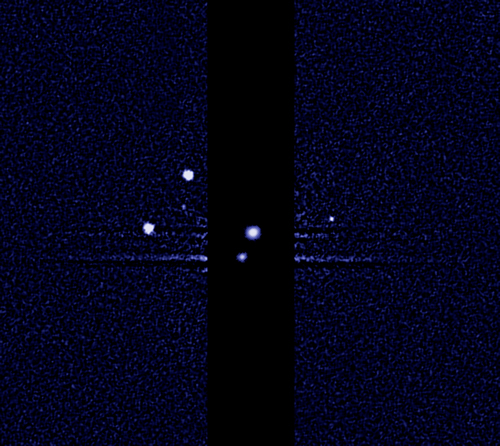
Safe passage: With the dust-impact hazard less than once feared, the New Horizons team plans to keep its spacecraft on the baseline trajectory through the Pluto system.
.
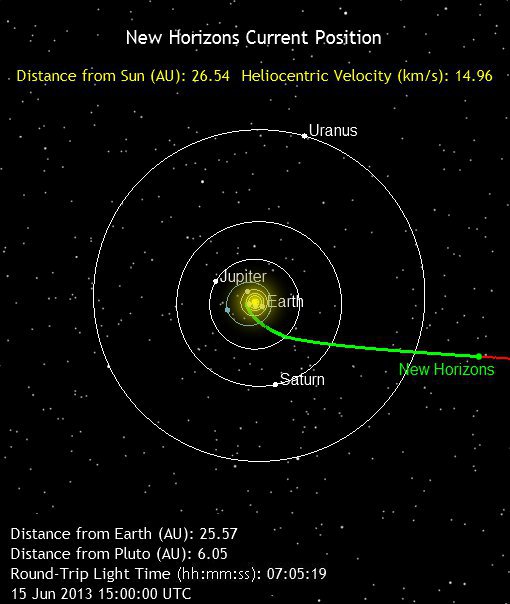
.
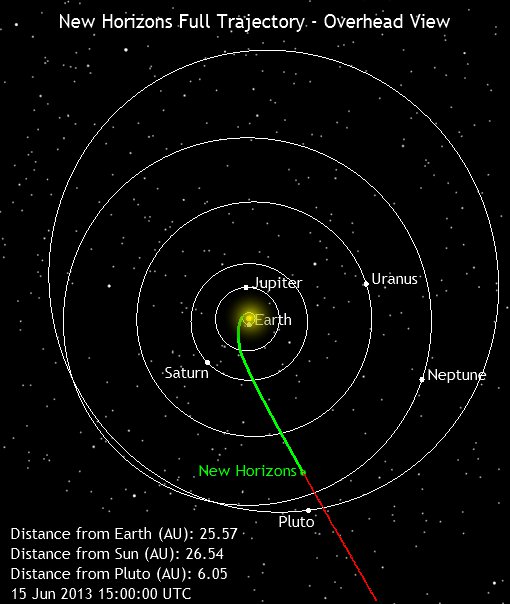
.
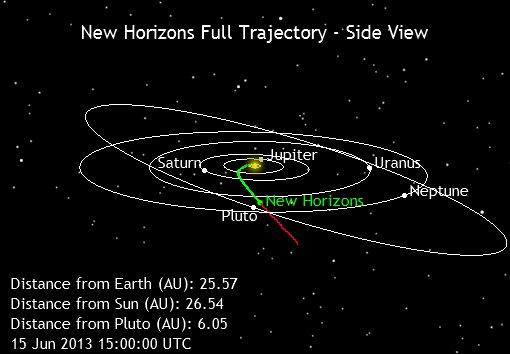
.
Update: 11.07.2013
.
NASA’s New Horizons spacecraft, now en route to Pluto, got its first glimpse of the dwarf planet’s largest moon, Charon, in this image released July 10.
Pluto is the bright spot in the center of the image. Charon is the faint smudge up and to the left. New Horizons snapped the picture at about 900 million kilometers from Pluto—six times the distance between Earth and the sun. At that distance, the light from Charon and Pluto takes about 48 minutes to reach New Horizons’s cameras. Charon is roughly the size of Texas, but to the approaching craft it appears no wider than a U.S. quarter seen from 17 kilometers away
Until 2005 Charon was Pluto’s only known moon. Since then astronomers using the Hubble Space Telescope have discovered four more: Nix, Hydra, Kerberos and Styx. Kerberos and Styx are the smallest, each only about a dozen kilometers across; they received their official names just last week.
Launched in early 2006 New Horizons is scheduled to pass within 13,000 kilometers of Pluto in July 2015. The flyby will give astronomers their first close-up look at the tiny world and its moons. Mission scientists will study Pluto’s terrain, composition and atmosphere as well as the space environment in an unexplored, distant corner of the solar system. In the meantime, as New Horizons races toward Pluto, it will frequently snap photos of the dwarf planet’s surroundings to better understand the orbits of the known moons and to look out for potential hazards, such as smaller moonlets or a system of dusty rings.
Pluto belongs to a belt of icy debris beyond Neptune called the Kuiper Belt. Out there, much of the debris left over from the solar system’s formation sits in frozen storage. By studying Pluto and its moons, astronomers learn about more than a single world—they gain access to a record of our solar system’s birth and subsequent growth. In the end, Pluto may be able to tell us more about ourselves and how we got here.
.

.
As NASA’s New Horizons probe powers through interplanetary space, it’s keeping a careful eye forward watching its target gradually loom larger on the proverbial celestial horizon. But earlier this month the spacecraft spotted something right next to Pluto — a pixelated Charon, the dwarf planet’s largest moon.
“The image itself might not look very impressive to the untrained eye, but compared to the discovery images of Charon from Earth, these ‘discovery’ images from New Horizons look great!” said New Horizons Project Scientist Hal Weaver, of the Johns Hopkins University Applied Physics Laboratory, Laurel, MD. “We’re very excited to see Pluto and Charon as separate objects for the first time from New Horizons.”
Quelle: D-News
.
.
.
.
Quelle: NASA
.
NASA’s Pluto-bound New Horizons spacecraft, using its highest-resolution telescopic camera, has spotted Pluto’s Texas-sized, ice-covered moon Charon for the first time. This represents a major milestone on the spacecraft’s 9½-year journey to conduct the initial reconnaissance of the Pluto system and the Kuiper Belt and, in a sense, begins the mission’s long-range study of the Pluto system.
.
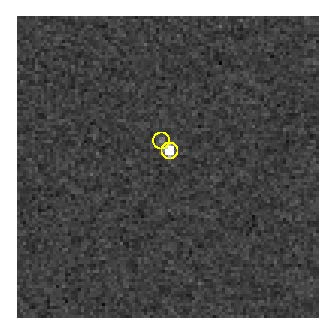
Pluto and Charon: New Horizons LOng Range Reconnaissance Imager (LORRI) composite image showing the detection of Pluto’s largest moon, Charon, cleanly separated from Pluto itself. The frame on the left is an average of six different LORRI images, each taken with an exposure time of 0.1 second. The frame to the right is the same composite image but with Pluto and Charon circled; Pluto is the brighter object near the center and Charon is the fainter object near its 11 o’clock position. The circles also denote the predicted locations of the objects, showing that Charon is where the team expects it to be, relative to Pluto. No other Pluto system objects are seen in these images.
When these images were taken on July 1 and July 3, 2013, the New Horizons spacecraft was still about 550 million miles (880 million kilometers) from Pluto. On July 14, 2015, the spacecraft is scheduled to pass just 7,750 miles (12,500 kilometers) above Pluto’s surface, where LORRI will be able to spot features about the size of a football field. (Credit: NASA/Johns Hopkins University Applied Physics Laboratory/Southwest Research Institute)
.
The largest of Pluto’s five known moons, Charon orbits about 12,000 miles (more than 19,000 kilometers) away from Pluto itself. As seen from New Horizons, that’s only about 0.01 degrees away.
“The image itself might not look very impressive to the untrained eye, but compared to the discovery images of Charon from Earth, these ‘discovery’ images from New Horizons look great!” says New Horizons Project Scientist Hal Weaver, of the Johns Hopkins University Applied Physics Laboratory, Laurel, Md. “We’re very excited to see Pluto and Charon as separate objects for the first time from New Horizons.”
The spacecraft was still 550 million miles from Pluto – farther than the distance from Earth to Jupiter – when its LOng Range Reconnaissance Imager (LORRI) snapped a total of six images: three on July 1 and three more on July 3. LORRI’s excellent sensitivity and spatial resolution revealed Charon at exactly the predicted offset from Pluto, 35 years after the announcement of Charon’s discovery in 1978 by James Christy of the Naval Observatory.
“In addition to being a nice technical achievement, these new LORRI images of Charon and Pluto should provide some interesting science too,” says New Horizons Principal Investigator Alan Stern, of the Southwest Research Institute. New Horizons is viewing Pluto and Charon at solar phase angles (the angles between the Sun, Pluto and spacecraft) much larger than can be achieved from observatories located on or near the Earth, potentially yielding important information about the surface properties of Charon and Pluto – perhaps the existence of an overlying layer of fine particles, for example.
“We’re excited to have our first pixel on Charon,” Stern continues, “but two years from now, near closest approach, we’ll have almost a million pixels on Charon –and I expect we’ll be about a million times happier too!”
.
35 Years Later: Charon is visible as a “bump” moving around Pluto in the moon’s
discovery images, taken with the 1.55-meter (61-inch) Kaj Strand Astrometric Reflector at the U.S. Naval Observatory’s Flagstaff Station in 1978. More than three decades later, Charon is visible for the first time in pictures (left) taken by the Pluto-bound New Horizons spacecraft.
Quelle: NASA
.
Update: 18.08.2013
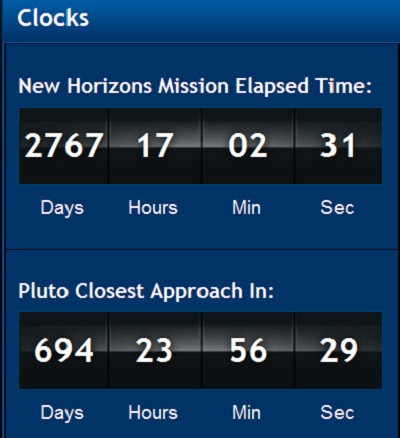
.
.
Update: 16.11.2013
.
Taking a Closer Look at Mysterious Pluto
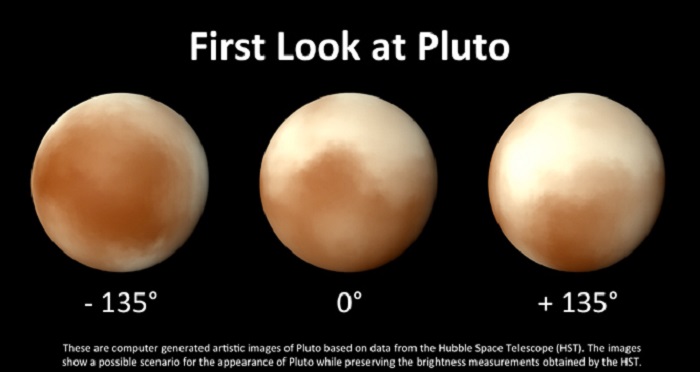
In July 2015, we will see some of the most monumental photos of spaceflight history. NASA’s New Horizons probe will blast through the Kuiper belt, imaging the region beyond Neptune’s orbit and gathering an intimate view of the Pluto-Charon system. But until that fateful flyby, we will have to make do with fuzzy observations of the distant dwarf planet, although a surprising amount of detail can still be gathered by powerful telescopes and rendered by sophisticated models.
Enter the Scientific Exoplanets Renderer (SER) as used by Abel Méndez, planetary scientist and director of the Planetary Habitability Laboratory at the University of Puerto Rico, to create a very cool view of the small, yet complex world.
SER is more commonly used to generate photo-realistic images of exoplanets, renderings of which can be found in the Visible Paleo-Earth project and the Habitable Exoplanets Catalog. By gathering as much observational data about planets orbiting other stars as possible — such as data from the complex light-curves of transiting exoplanets — and feeding the SER, artistic renderings based on real observations can be generated. The more data available, the more precise the model.
So, looking a little closer to home, Méndez applied SER to Pluto. By feeding the algorithm with albedo data from the Hubble Space Telescope, he generated a “basic representation” of Pluto. For now, the model only uses albedo maps from Hubble (i.e. the brightness variations as mapped across Pluto’s surface), but Méndez plans to “produce more creative” versions, adding more detail to the apparent surface features.
“It will be fun to compare our progress, starting from our first image, until the final close-up pictures of Pluto on July 2015,” writes Méndez.
Interestingly, Méndez applied the same color palette as used to color observations of Triton, Neptune’s strange moon. Triton has a retrograde orbit around the ice giant (i.e. it orbits in the other direction to all the other 13 known Neptunian satellites) and has a very different composition leading planetary scientists to theorize that it is actually a captured Kuiper belt object and a close cousin to Pluto. Therefore there’s every reason to believe that we will spot some uncanny similarities between Pluto and Triton when seen up close.
In the run-up to the New Horizons flyby, there will be lots of opportunities to refine the model with new data.
Although he has yet to evaluate the SER Pluto model, New Horizons Principle Investigator Alan Stern, planetary scientist at the Southwest Research Institute, is keen to point out that as the spacecraft approaches the outer solar system observations of Pluto will become more and more detailed, inevitably enriching models like Méndez’s visualization.
“We will be imaging Pluto for navigational purposes beginning next summer, and then beginning in 2015 for science,” Stern said in an email to Discovery News. “We will surpass Hubble resolution in April, 2015. By June 2015 the image improvements will be dramatic, and improving noticeably each week. Approach imaging will be done both panchromatically and in color, and will be dense enough to create approach movies of Pluto and it’s satellite system.”
Before New Horizons’ robotic eyes start to resolve what promises to be an awe-inspiring moment in human ingenuity and spaceflight history, it will be fun to see computer models gain more and more detail until, eventually, we can compare them with the real thing in July 2015.
Quelle: D-News
.
Update: 15.01.2014
.

Are we there yet?
One of the fastest spacecraft ever built -- NASA's New Horizons -- is hurtling through the void at nearly one million miles per day. Launched in 2006, it has been in flight longer than some missions last, and it is nearing its destination: Pluto.
“The encounter begins next January,” says Alan Stern, of the Southwest Research Institute and the mission’s principal investigator. “We’re less than a year away.”
.
.
.
Closest approach is scheduled for July 2015 when New Horizons flies only 10,000 km from Pluto, but the spacecraft will be busy long before that date. The first step, in January 2015, is an intensive campaign of photography by the Long Range Reconnaissance Imager or “LORRI.” This will help mission controllers pinpoint Pluto's location, which is uncertain by a few thousand kilometers.
.

"LORRI will photograph the planet against known background star fields," explains Stern. "We’ll use the images to refine Pluto’s distance from the spacecraft, and then fire the engines to make any necessary corrections.”
At first, Pluto and its large moon Charon will be little more than distant pinpricks—“a couple of fat pixels,” says Stern--but soon they will swell into full-fledged worlds.
By late April 2015, the approaching spacecraft will be taking pictures of Pluto that surpass the best images from Hubble. By closest approach in July 2015, a whole new world will open up to the spacecraft’s cameras. If New Horizons flew over Earth at the same altitude, it could see individual buildings and their shapes.
Stern is looking forward to one of the most exciting moments of the Space Age.
“Humankind hasn't had an experience like this--an encounter with a new planet--in a long time,” he says. “Everything we see on Pluto will be a revelation.”
He likens New Horizons to Mariner 4, which flew past Mars in July 1965. At the time, many people on Earth, even some scientists, thought the Red Planet was a relatively gentle world, with water and vegetation friendly to life. Instead, Mariner 4 revealed a desiccated wasteland of haunting beauty. New Horizons’ flyby of Pluto will occur almost exactly 50 years after Mariner 4’s flyby of Mars—and it could shock observers just as much.
Other than a few indistinct markings seen from afar by Hubble, Pluto’s landscape is totally unexplored. Although some astronomers call Pluto a “dwarf” planet, Stern says there’s nothing small about it. “If you drove a car around the equator of Pluto, the odometer would rack up almost 5,000 miles—as far as from Manhattan to Moscow.” Such a traveler might encounter icy geysers, craters, clouds, mountain ranges, rilles and valleys, alongside alien landforms no one has ever imagined.
“There is a real possibility that New Horizons will discover new moons and rings as well,” says Stern.
Yes, Pluto could have rings. Already, Pluto has five known moons: Charon, Styx, Nix, Kerberos, and Hydra. Numerical simulations show that meteoroids striking those satellites could send debris into orbit, forming a ring system that waxes and wanes over time in response to changes in bombardment.
“We’re flying into the unknown,” says Stern, “and there is no telling what we might find.”
.
.
.
.
.
.
Quelle: NASA
.
Update: 9.02.2014
.
Thanks America, New Horizons Ahead
.
New Horizons completed a quick, two-week maintenance wakeup on Jan. 17 and is back in hibernation. We’ll wake the craft again in mid-June for our last active checkout, lasting about 10 weeks, on the journey to Pluto. We’ll hibernate again from late August through early December, and then wake our baby up for the encounter we built her for.
Having launched New Horizons in January 2006, we’ve been in flight now for over eight years – longer than most space missions last – and we are finally nearing “showtime.”
By this time next year, we will be executing the earliest phases of our Pluto system encounter. Closest approach is now just 17 months away! That may seem like a while to you, but after almost 97 months in flight, it’s just around the corner to us. Most people may not appreciate it, but 2014 is the last year, forever, that Pluto and its moons will be known only as points of light or smudgy images to humankind.
Our Stories
Beginning this summer, we will take you along with us more intimately on our preparations to explore the Pluto system.
The stories we’re going to tell as encounter approaches, culminates and recedes will cover more than the progress of our encounter flight plan and the data we’ll receive —though those elements will certainly be covered well too.
But in addition, we’re also going to tell the story of how and why this mission was funded – by being ranked the No. 1 priority of the National Academy’s 2000s decadal survey in planetary science. Also, we’re going to be talk about U.S. leadership and preeminence in planetary exploration, of which New Horizons is one kind of demonstration. But there’s more.
We’re going to talk about the danger of debris strikes that our lone spacecraft may face as it flashes through the Pluto system on the morning of Tuesday, July 14, 2015 – and the decisions our team will have to make about those risks. We’ll also talk about the extreme degree of persistence it took on the part of the scientific community and the mission team, weathering five cancellations, a plutonium fuel shortage, the death of key project engineers, and more, to get this mission funded, and built and launched on a schedule so tight that many people thought it could not be done.
We’re going to talk about the dream of exploring Pluto becoming reality, and the large role teamwork played in that. We’re also going to recount the work of 20th century astronomical pioneers Percival Lowell, Clyde Tombaugh and Gerard Kuiper – whose pluck, persistence and personal skill led to the discovery of Pluto and the Kuiper Belt.
So too, we’ll discuss what planetary scientists have discovered lately about the diversity of planets in our solar system — and that vast, new, third zone of the solar system called the Kuiper Belt.
We’re going to talk about New Horizons launching faster and going farther than any space mission ever has to reach its prime target. And we’re going to talk about the high-tech miniaturization that makes New Horizons the successor to the Voyagers at only a fraction of their size, and mass and cost.
And we’re going to talk about humankind’s insatiable urge to explore new frontiers.
So stay tuned, we’re almost there.
.
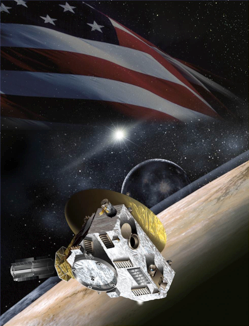
Thanks
Before I close this PI Perspective, and before we begin this encounter with its earliest precursor events this summer, I want to say a heartfelt thanks.
First, a big thanks to you – for following our little spacecraft across eight years and nearly three billion miles of almost unfathomable emptiness called space, as it’s undertaken a trailblazing, truly larger-than-life journey to a far away frontier, and into history.
And my even bigger thanks go to the American people, for supporting NASA and its historic and unmatched program of planetary exploration. We on the New Horizons project like this particular artist’s concept of our flyby at the top of this PI log. We like to show it off too, because we know who paid for this mission.
We’re going to do our best to make you proud, to deliver the goods at Pluto, and to tell you the many stories that form the narrative of New Horizons along the way.
Hold on to your hats, the curtain on those stories is about to rise!
Keep on exploring; we will too!
.

Quelle: NASA
.
Update: 2.03.2014
.
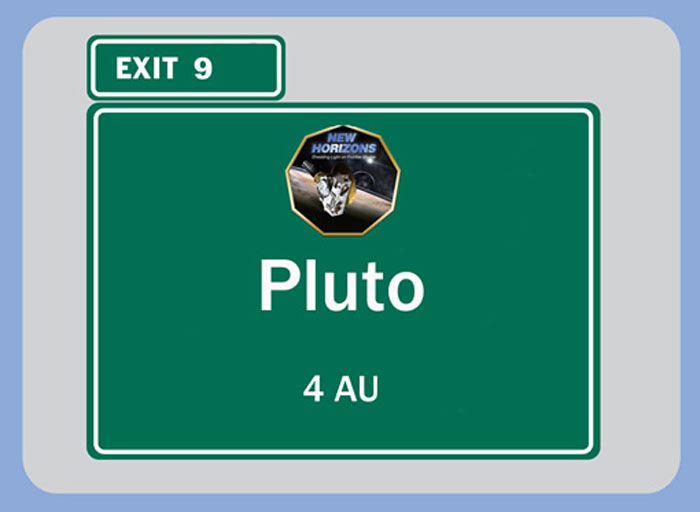
New Horizons Reaches the Final 4 (AU)
Did you know? An astronomical unit (AU) is the average distance between the Earth and sun, about 93 million miles or 149 million kilometers. New Horizons’ journey from Earth to Pluto will cover more than 32 AU.
New Horizons sailed past another milepost today when the NASA spacecraft moved to within four astronomical units (AU) of Pluto – which is less than four times the distance between the Earth and the sun, or about 371 million miles (598 million kilometers).
"We're as close to the Pluto system now as Earth ever gets to Jupiter, a first for any spacecraft,” says New Horizons Principal Investigator Alan Stern, of the Southwest Research Institute, Boulder, Colo. “And hold on to your hat, it just gets more and more exciting from here."
Since launch on January 19, 2006, New Horizons has covered nearly 2.89 billion miles (4.62 billion kilometers). It makes a temporal connection with one NASA’s legendary deep-space explorers this summer when it crosses the orbit of Neptune on Aug. 25 — exactly 25 years after Voyager 2 made its historic flight past that giant planet. When New Horizons arrives at Pluto on July 14, 2015, it will have traveled farther than any spacecraft ever has to reconnoiter its prime target.
Quelle: NASA
.
Update: 21.05.2014
.
Pluto-bound probe faces crisis
NASA scientists scramble to find an object in the outer Solar System’s Kuiper belt in time for a close-up visit.
.
Nearly 4.3 billion kilometres from Earth, and most of the way to Pluto, NASA’s New Horizons spacecraft is in danger of missing out on half of its mission. Project managers face a looming deadline to identify an icy object in the outer Solar System for the probe to fly by after it passes Pluto.
A visit to a Kuiper belt object, or KBO, was always meant to be a key part of New Horizons’ US$700-million journey, which began in 2006. But there is only a slim chance that astronomers will find a suitable KBO with their current strategy of using ground-based telescopes — and securing time on the orbiting Hubble Space Telescope is far from guaranteed.
New Horizons will fly past Pluto in July 2015. Soon afterwards, it must fire its engines and set itself on course to fly past a selected KBO. Project scientists must identify a KBO in the next several months if they are to determine the necessary trajectory well enough for New Horizons to aim accurately and meet its target.
“They’re running out of time,” says Mark Sykes, director of the Planetary Science Institute in Tucson, Arizona, who is not involved in the mission. “We’re not just talking about science being lost — we’re talking about getting return on our investment.”
New Horizons scientists have asked for 160 orbits’ worth of observing time on the hugely oversubscribed Hubble. It is a rare request for a NASA mission already in operation. The committee that allocates Hubble time will make a decision by 13 June.
The two targets of New Horizons — Pluto and a KBO — each promise different rewards. “Two different scientific communities are getting excited about it,” says Will Grundy, mission co-investigator at the Lowell Observatory in Flagstaff, Arizona. The Pluto fly-by will be the first close-up glimpse of this geologically active world and its moons. The KBO visit, 2–3 years later (see ‘Far horizons’), would be the best look yet at one of these primordial icy bodies — time capsules from the early days of the Solar System.
.

In theory, project scientists should have identified a suitable KBO long ago. But they postponed their main search until 2011, waiting for all the possible KBO targets to begin converging on a narrow cone of space that New Horizons should be able to reach after its Pluto encounter. Starting to look for them before 2011 would have been impossible, says Grundy, because they would have been spread over too much of the sky.
Now that the hunt for KBOs is on, the New Horizons researchers have mainly been using the 8.2-metre Subaru Telescope in Hawaii and the 6.5-metre Magellan Telescopes in Chile. They have found about 50 new KBOs; none is close enough for New Horizons to reach.
Part of the problem is that the search area is in the Galactic Plane, where most of the Milky Way’s stars are. The bright stars tend to outshine the light coming from the faint KBOs, and the crowded field of view means that the discovery rate depends strongly on observing conditions. Bad weather and poor-quality observation on many nights has ruined much of the search.
Early on, the team also overestimated the number of KBOs that it would find. In the past couple of years, astronomers have discovered that there are fewer dim KBOs than was extrapolated on the basis of the number of bright ones. “There just aren’t as many faint ones,” says Grundy — and faint, faraway KBOs are what New Horizons must detect.
For a mission that has been carefully planned for many years, the failure to find a KBO target is striking. But Sykes is not alarmed. “That should have been in the calculus, but it really wouldn’t have changed their ground-based campaign,” he says.
The team has another eight nights with Subaru in late June and July, and hopes to win some more time in August. It has also applied for extra observing time with Magellan in October. Even if conditions are near perfect, the chances of snaring a KBO from the ground this year are less than 40%. With the requested Hubble time, those chances soar to greater than 90%.
Without Hubble, it might still be possible to identify a KBO target from the ground early next year. But that would complicate the mission, because New Horizons would have to wait for longer after visiting Pluto to fire its engines. In that case, the spacecraft would need to execute a sharper turn than team scientists would like to reach the correct trajectory.
In the worst-case scenario, New Horizons would be forced to observe a KBO from far away. Several possible long-distance targets have already been spotted (S. D. Benecchi et al. Icarus http://doi.org/ssn; 2014). Even with its puny 21-centimetre telescope, New Horizons would get a better glimpse of a distant KBO than the 2.4-metre Hubble can manage from an Earth orbit.
Not that the team has yet given up hope of a close KBO target. “If we can find one,” says Grundy, “we will happily take it.”
Quelle: nature
.
Update: 7.06.2014
.
Assessing Pluto from Afar
Worldwide, Ground-based Astronomy Campaign Supports New Horizons
When New Horizons speeds past Pluto in July 2015, its set of sophisticated cameras and sensors won’t be the only high-tech “eyes” trained on the distant planet and its moons. The New Horizons mission team has officially kicked off its two-year-long Earth-based Observation Campaign, an opportunity for astronomers around (and above) the globe to observe Pluto while New Horizons approaches and passes it.
“New Horizons offers a once-in-a-lifetime opportunity to measure in situ the state of the Pluto-Charon system,” said Richard Binzel, a New Horizons co-investigator from Massachusetts Institute of Technology, who leads the campaign. “After decades of measuring the system through Earth-based telescopes we know it is very dynamic, and also realize that the New Horizons flyby provides a snapshot of a single moment in the system. We want to establish an extensive context using Earth-based telescopes for the state of the Pluto system at the time of the flyby, including evolving trends in the system for at least one year prior- and post-flyby.”
Here’s how the program works: the New Horizons team puts out international calls for its “most wanted” observations, encouraging individual or teams of planetary astronomers to propose observation campaigns to various telescopes. The program’s five phases match the separate stages of New Horizons’ own encounter at Pluto, such as pre-encounter (now through October 2014), immediate approach (April-May 2015), encounter (June-August 2015), immediate post-encounter (September-October 2015) and later post-encounter (April-December 2016).
“Of course, simultaneous ground- and space-based measurements when New Horizons flies past Pluto [on July 14, 2015] are important for calibration and context,” Binzel said. “But observations before and after the flyby are just as important.”
.
.
Quelle: NASA
.
Update: 15.06.2014
.
NEW HORIZONS SPACECRAFT WILL WAKE UP TODAY
Pluto, are you ready for your closeup? Controllers of the New Horizons spacecraft are counting down the days until the closest encounter with the dwarf planet about a year from now.
Meanwhile, today (15 June) they will temporarily wake up the spacecraft from its power-saving hibernation mode to check on its systems and perform some preliminary science ahead of the flyby in July 2015.
"This summer’s hibernation wakeup will be a particularly busy operation," wrote Alan Stern, the principal investigator of New Horizons, in an update on the spacecraft's web site.
"In addition to the complete checkout of the spacecraft’s primary and backup systems, and similar checkouts of all seven scientific instruments, we’ll also conduct our first optical navigation campaign to home in on Pluto, track the spacecraft to refine its orbit, do a host of instrument calibrations needed before encounter, carry out a small but important course correction, and gather some cruise science."
The spacecraft will be tasked to look at the light curves of Pluto and its satellites, sending back information on the brightness of each of these objects and their rotation. While this is possible to do from Earth, the blog post noted, the spacecraft will be closer and at a different angle. Controllers plan to produce a rotation movie of Pluto's largest moon, Charon.
New Horizons will also cross the orbit of Neptune on 25 August, which by pure coincidence is the 25th anniversary of when the Voyager 2 spacecraft made its closest approach to the blue gas giant.
Once the summer's work is over, controllers will put the spacecraft into hibernation again until December. That will be the beginning of the main event. Controllers will take an exact fix on Pluto's position that January. They expect the flyby to take place in July 2015. The spacecraft will remain awake for about two years, working on the flyby and also sending information back to Earth.
"Although we still have a little more than 300 million miles [483 million km] and a year to go, the mileage and time already traveled account for nearly 90 percent of the total journey—so we are truly in the last stages of the cruise from Earth to the Solar System’s vast unexplored frontier," Stern added.
In a separate development, a new NASA-led study suggests that Pluto's moon Charon could have cracks in its surface. The moon, one-eighth the size of the dwarf planet, was probably formed when an object struck Pluto's surface in the distant past, and formed debris that eventually coagulated into Charon.
Since Charon and Pluto would have been extremely close in the first while after Charon formed, the gravitational attraction between the objects would have made their surfaces bulge towards each other and could have induced tidal heating in both Charon and Pluto.
If Charon is icy, the tidal heating could have heated up fluids below its surface, producing cracks and creating a global ocean. (That is also a theory for the cracked moons Europa and Enceladus.) But NASA cautioned that it's possible that the ocean, if it exists, would be frozen over now since Charon's orbit has migrated to a more stable location that does not have the same stresses.
The research was led by Alyssa Rhoden of NASA's Goddard Space Flight Center in Maryland and is available in the journal Icarus.
Quelle: SEN
.
Update: 18.06.2014
.
Final Pre-Pluto Annual Checkout Begins
Horizons' annual checkout - its eighth since launch in 2006 and last before next year's rendezvous with Pluto - kicks off this week with some onboard subsystem housekeeping and navigation-tracking tasks. But the pace picks up soon enough with a slate of operations that carries through most of the summer.
Early on June 15, flight controllers at the Johns Hopkins Applied Physics Laboratory in Laurel, Maryland, configured their ground systems to receive telemetry from the spacecraft as it transitioned out of its low-activity hibernation mode, where it had been since mid-January. They, along with NASA Deep Space Network operators and other team members, monitored New Horizons for most of the day to verify that all systems were normal.
"New Horizons is healthy and ready for its last summertime workout before the Pluto encounter, nearly three billion miles from home," says Alice Bowman, mission operations manager at APL.
Over the next few days the team will transmit more commands through the DSN - NASA's worldwide network of large-antenna stations - to configure New Horizons for the checkout.
Initial activity ranges from refreshing the processors on the spacecraft's computers, to testing the sun sensors New Horizons uses to automatically determine its position in space, to enabling the small thrusters that position New Horizons for observations and other operations.
Additionally, over four intense days in late June, the final planned version of the autonomy software that guides collection of and protects the data collected during Pluto close approach will be uploaded into the spacecraft's memory.
Over the next 11 weeks, among other activities, the team will check out the spacecraft's primary and backup operating systems as well as all seven scientific instruments - the instruments will also be calibrated and set to gather "cruise science" data that includes a distant examination of the surfaces of Pluto and its moons.
The LORRI camera will also be used to carry out the first optical navigation campaign - snapping images that will help the team home in on Pluto - and the navigation team will track the spacecraft to refine its orbit.
A trajectory correction maneuver is tentatively scheduled for July 15 - if needed - to keep New Horizons on a straight path toward the Pluto system. New Horizons will cross the orbit of Neptune on Aug. 25. - exactly 25 years after Voyager 2 encountered the gas giant planet - and re-enter hibernation on Aug. 29.
Quelle: SD
.
Update: 2.07.2014
.
Hubble to Proceed with Full Search for New Horizons Targets
Planetary scientists have successfully used the Hubble Space Telescope to boldly look out to the far frontier of the solar system to find suitable targets for NASA's New Horizons mission to Pluto. After the marathon probe zooms past Pluto in July 2015, it will travel across the Kuiper Belt a vast rim of primitive ice bodies left over from the birth of our solar system 4.6 billion years ago. If NASA approves, the probe could be redirected to fly to a Kuiper Belt object (KBO) and photograph it up close.
As a first step, Hubble found two KBOs drifting against the starry background. They may or may not be the ideal target for New Horizons. Nevertheless, the observation is proof of concept that Hubble can go forward with an approved deeper KBO search, covering an area of sky roughly the angular size of the full Moon. The exceedingly challenging observation amounted to finding something no bigger than Manhattan Island, and charcoal black, located 4 billion miles away.
.
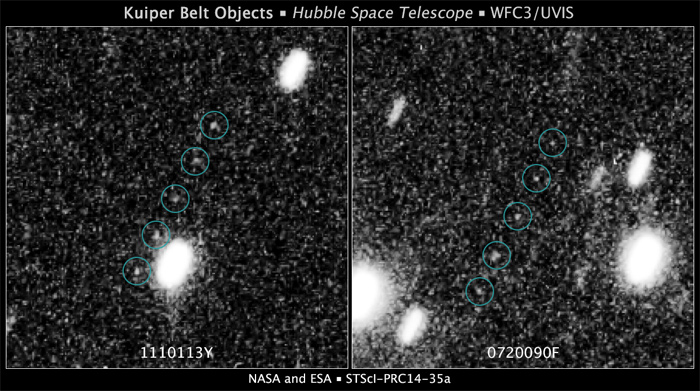
These images are from a Hubble Space Telescope survey to find Kuiper Belt objects (KBOs) in support of NASA's New Horizons mission to Pluto. The Kuiper Belt is a debris field of icy bodies left over from the solar system's formation 4.6 billion years ago.
Once the New Horizons craft flies by Pluto in mid-2015, the team's goal is to get NASA's approval to retarget the probe to fly by a KBO, which might only measure 20 miles across.
To test the feasibility of finding New Horizons targets with Hubble, a set of pilot Hubble observations were executed in June 2014. After a swift and intensive data analysis of approximately 200 Hubble images, the New Horizons team met the pilot program criterion of finding a minimum of two KBOs.
Multiple exposures taken with Hubble tracked the KBOs moving against the background field of stars in the summer constellation Sagittarius.
The image at left shows a KBO at an estimated distance of approximately 4 billion miles from Earth. Its position noticeably shifts between exposures taken approximately 10 minutes apart. The image at right shows a second KBO at roughly a similar distance.
The positions of these newly discovered objects are not consistent with any KBOs discovered previously. In reality, they are too faint to have been seen with ground-based telescopes (magnitudes 26.8 and 27.3, respectively).
It will be many weeks before the team can establish whether either of these pilot-program KBOs is a suitable target for New Horizons to visit, but their discovery provides sufficient evidence that a wider search to be executed with Hubble will find an optimum object.
Quelle: NASA
.
Update: 6.08.2014
.
Genaue Messwerte für New Horizons Pluto-Sonde
Radio Readings Pinpoint Pluto for New Horizons Probe
Radio readings from an array of antennas in Chile are helping the scientists behind NASA's New Horizons mission to Pluto determine the dwarf planet's precise position — so that the spacecraft can zero in properly during next July's flyby. Pluto is 40 times farther away from the sun than Earth, and it's been tracked for only 84 years' worth of its 248-year ORBIT. “With these limited observational data, our knowledge of Pluto’s position could be wrong by several thousand kilometers," New Horizons project scientist Hal Weaver explained in a news release from the National Radio Astronomy Observatory.
Scientists are cutting that uncertainty in half by picking up faint radio emissions from Pluto and its largest moon, Charon, using the Atacama Large Millimeter/Submillimeter Array (better known as ALMA). Those emissions, plus newly analyzed visible-light measurements, were compared with radio readings from a cosmic reference point — a distant quasar known as J1911-2006. New Horizons' principal investigator, Alan Stern, said the results should "HELP us better target our historic exploration of the Pluto system."
Quelle: NBC
.
Update: 7.08.2014
.
ALMA Pinpoints Pluto to Help Guide NASA’s New Horizons Spacecraft

The cold surface of Pluto and its largest moon Charon as seen with ALMA on July 15, 2014
.
stronomers using the Atacama Large Millimeter/submillimeter Array (ALMA) are making high-precision measurements of Pluto's location and orbit around the Sun to HELP NASA’s New Horizons spacecraft accurately home in on its TARGETwhen it nears Pluto and its five known moons in July 2015.
Though observed for decades with ever-larger optical telescopes on Earth and in space, astronomers are still working out Pluto's exact position and path around our SOLAR SYSTEM. This lingering uncertainty is due to Pluto's extreme distance from the Sun (approximately 40 times farther out than the Earth) and the fact that we have been studying it for only about one-third of its orbit. Pluto was discovered in 1930 and takes 248 years to complete one revolution around the Sun.
“With these limited observational data, our knowledge of Pluto’s position could be wrong by several thousand kilometers, which compromises our ability to calculate efficient targeting maneuvers for the New Horizons spacecraft,” said New Horizons Project Scientist Hal Weaver, from the Johns Hopkins University Applied Physics Laboratory in Laurel, Maryland.
The New Horizons team made use of the ALMA positioning data, together with newly analyzed visible light measurements stretching back to Pluto's discovery, to determine how to perform the first such scheduled course correction for targeting, known as a Trajectory Correction Maneuver (TCM), in July. This maneuver helped ensure that New Horizons uses the minimum fuel to reach Pluto, saving as much as possible for a potential extended mission to explore Kuiper Belt objects after the Pluto system flyby is complete.
To prepare for this first TCM, astronomers needed to pinpoint Pluto's position using the most distant and most stable reference points possible. Finding such a reference point to accurately calculate trajectories of such small objects at such vast distances is incredibly challenging. Normally, stars at great distances are used by optical telescopes for astrometry (the positioning of things on the sky) since they change position only slightly over many years. For New Horizons, however, even more precise measurements were necessary to ensure its encounter with Pluto would be as on-target as possible.
The most distant and most apparently stable objects in the Universe are quasars, galaxies more than 10 billion light-years away. Though quasars appear very dim to optical telescopes, they are incredibly bright at radio wavelengths, particularly the millimeter wavelengths that ALMA can see.
“The ALMA astrometry used a bright quasar named J1911-2006 with the goal to cut in half the uncertainty of Pluto's position,” said Ed Fomalont, an astronomer with the National Radio Astronomy Observatory in Charlottesville, Virginia, and currently assigned to ALMA’s Operations Support Facility in Chile.
7893 Views

